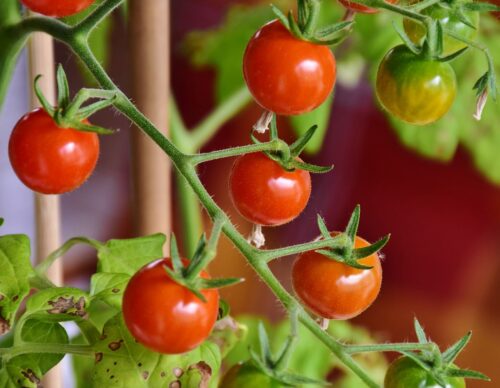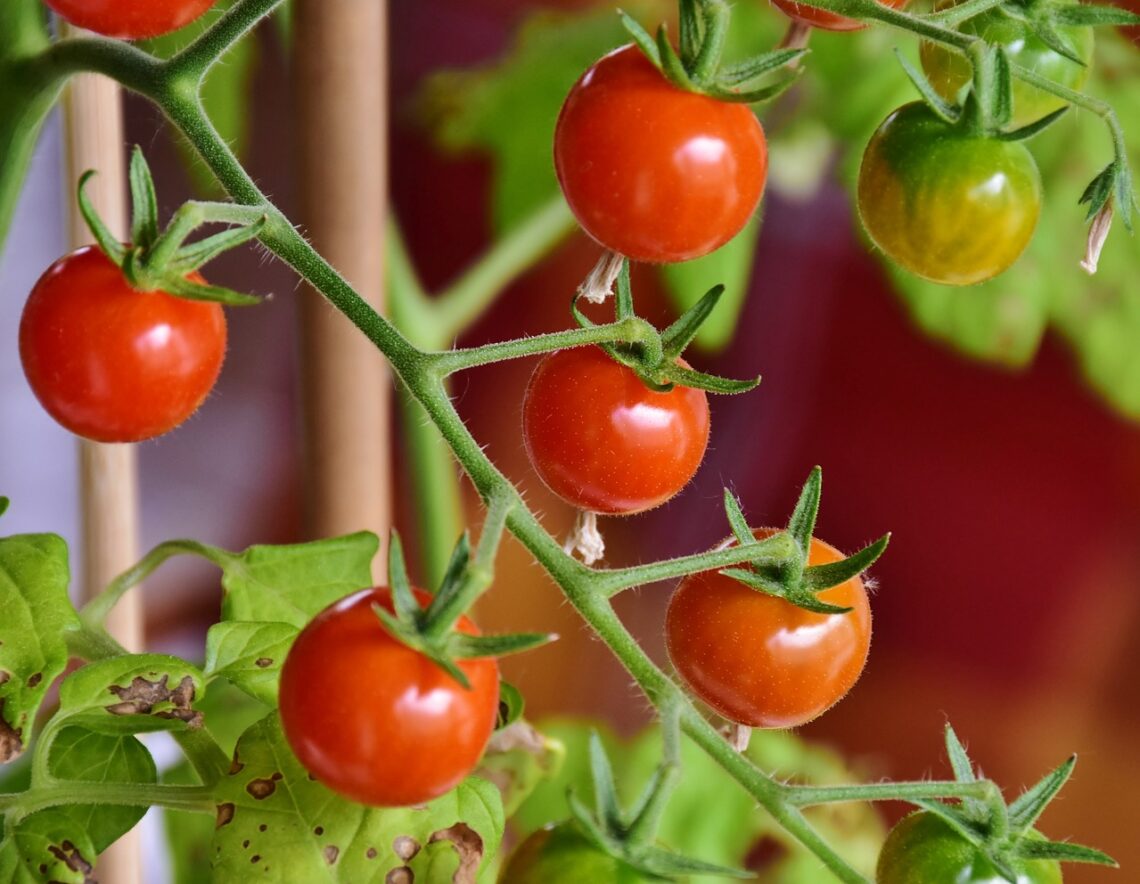Read about the Common Tomato Problems & Solutions in this detailed post and harvest healthy and juicy tomatoes.
If you don’t have any idea about major and common Tomato Problems & Solutions, then read this post for harvesting the best tomatoes year-round.
Common Tomato Problems & Solutions

1. Few flowers or flowers dropping
If your tomato plant is showing few blooms or the flowers are dropping before setting fruit, it can be due to the following reasons;
- Excessive nitrogen
- Stress from drought
- Lack of sunlight
- Day temperature above 85 F
- Night temperature below 50 F or above 70 F
Solution: The most common cause of dropping or few blooms is the weather. Plants enliven when the climate issue passes. Stop feeding the plant with nitrogen-based fertilizer; just water at the ground level and mulch.
2. Leaf curl/ Leaf rolling
This issue arises at the bottom of a tomato plant due to high temperatures or wet soil, which causes stress. It may look unpleasant but does not affect tomato development.
Solution: You can overcome this issue by avoiding over-pruning and growing plants in well-draining soil or pots with enough drainage holes.
3. Sunscald
Symptoms of sunscald develop when tomato plants mature, yellow patches emerge on fruit which becomes white and very thin. This not only affects the appearance but also impacts the flavor. As the name sounds, tomatoes are scalded by the sun.
Solution: To save tomato plants from sunscald, install a strong wire cage around the plant that provides steady branch support and natural shade for young fruits.
Note: Most often, sunscalds emerge on plants that are pruned heavily, leaving fewer leaves and branches.
4. Wilting plants
Tomato plants suffering from Fusarium Wilt look well one day and abruptly start to wilt the next day. This problem is caused by a fungus that strikes the vascular system of the plant. The fungus ruins the xylem tubes that transfer water and nutrients from the roots to foliage. At first, only one side is affected, but soon, the entire plant wilt. Water aggravates the condition, and the plant dies soon.
Solution: Preventive measures are the best way to manage this condition. Crop rotation is necessary; buy wilt-resistant tomato cultivars. This fungus lives in the soil throughout the winter, so avoid planting tomatoes in the same area each year.
5. Powdery mildews
If your tomato plant is affected by powdery mildew, the leaves will appear brushed with a fine white powder, and white spots on the stem will emerge. The foliage will also become yellow and brown.
Powdery mildew took place in high humidity, and poor air circulation, this issue is common in greenhouses. Follow the natural measures to overcome this problem below;
- Garlic: The high sulfur content acts as an antifungicide. You can buy garlic oil or make it yourself. Coat the foliage with the diluted solution bi-weekly until the condition comes under control.
- Milk: Make a solution of 60 percent milk and 40 percent water, use this spray on the affected area. When the milk is exposed to the sunlight it generates free radicals that kill the fungus. Use it twice a week for best results.
- Apple Cider Vinegar: The acid level in vinegar kills the mildew, make sure to add only 4 tablespoons of apple cider vinegar to one gallon of water. Use on foliage every three days.
- Baking Soda: Mix one tablespoon baking soda and 1/2 teaspoon liquid soap with a gallon of water and fill in a spray bottle, use on the affected leaves. Do not apply during daylight hours. Perform a patch test on a few leaves to find the solution doesn’t burn the plant.
- Copper fungicide: It can be an effective measure; follow the instructions on the label.
6. Puffiness
There is a huge difference between plump and puffy tomatoes, when you slice the fruit the large open spaces, lighter weight, and angular shape are signs of puffiness. This issue is caused by poor soil, lack of nutrients, or insufficient pollination.
Solution: Make sure to feed the plants during the growing season, remember that tomatoes are heavy feeders. A regular top dressing of homemade compost is essential for healthy fruit.
7. Brown spots on foliage
Spots emerge on old foliage and create rings like targets. After they become yellow around the brown spot, the whole leaf becomes brown and falls. This problem is known as early blight, and it is caused by a fungus that hibernates in the soil.
Solution: To prevent this issue in newly planted tomatoes, rotate crops. Improve air circulation by staking and pruning the plants. Clean the pruning shears with one part bleach and four parts water after every cut. Keep the decaying material distant from plants, and apply a layer of organic compost under plants.
Keep the leaves dry by installing a drip irrigation. Mix one teaspoon of baking soda with 1 quart of water and two and a half tbsp of vegetable oil so the solution sticks to the plant. Fill the solution in a spray bottle and apply it to the plant in the evening or morning hours.
8. Bulls-eye circle on the blossom end
A slushy bull-eye circle on the tomato is a symptom of anthracnose, it is soft to touch and shows a black spot under the skin upon slicing. It appears in hot, moist weather, and spread when water gaps on the ground pressing the fungus upward.
Solution: Prevent this issue by installing a drip irrigation system that waters only the base of the plant. Make sure to harvest tomatoes once they are ripe.
9. Poor fruit set
Excessive supply of nitrogen produces green bushy plants with few blooms and small and tasteless fruits. Insufficient spacing between plants doesn’t allow correct pollination, which causes poor fruit sets.
Solution: Leave at least two feet or more between plants for pollination and air circulation, and shake the blooming branches for pollination.
10. Holes in the fruit
Tomato fruit worms can cause small holes. The moth larvae form holes in fruits and start eating from the inside out. When the larvae make a hole, the only solution you have is to destroy the infected fruit.
Solution: If you have a persistent issue with fruit worms then start your plant under row covers, and keep them covered till they bloom.
11. Fruit cracking
Tomatoes may experience circular cracking, which invites birds and insects to munch on the fruit. It arises due to hot and rainy weather. In an arid climate with little rain, thirsty fruits absorb water rapidly, causing tomatoes to swell and crack.
Solution: Make sure to give sufficient moisture in the growing season. This will keep the fruit from turning excessively thirsty in heavy rainstorms.
12. Deformed fruit
If the fruit is misshapen, the flower end is crimped and lumpy, it happens due to pollination when the temperature were cool 50-55 F.
Solution: Plant tomatoes a bit late when the weather is warm. Use black plastic on the soil to help plants remain warm during the night.
13. Fruit with black sunken areas on the blossom end
A black sunken spot is blossom end rot that appears like a disease but is caused by a lack of calcium. It is also worsened by irregular watering, dry conditions, root damage, or excess nitrogen. The good thing is that just a few tomatoes are affected at the start of the harvesting time.
Solution: Provide your fruit with sufficient calcium, and apply crushed eggshells in both planting holes and around the base of the plant. Water the plants deeply twice a week for healthy root growth.



